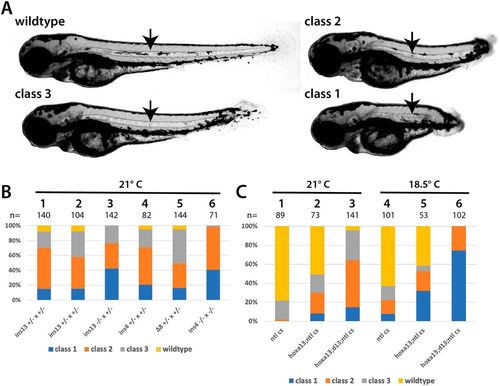
Interaction between the Hox13 genes and tbxta/ntl. (A) Classification used to score embryos at 3 dpf. The strongest class, class 1, has the same phenotype as tbxta/ntl mutants. Class 2 mutants have a clearly truncated axis, and extend beyond the anus at the end of the yolk tube. Class 3 mutants have relatively minor posterior defects. All classes of embryos have a notochord (arrow). (B) Embryos raised from different crosses that were placed at 21°C at shield stage and scored at 3 dpf. The specific hoxd13a mutation is shown; all fish were homozygous for both hoxa13bΔ16 and ntlcs. The embryos shown in columns 1 and 2 are from two separate families with the same genotype. (C) Embryos raised from different crosses that were placed at 21°C or 18.5°C at shield stage and scored at 3 dpf. The labels for each column refer to the adults used in the cross: ntl cs, homozygous for ntlcs; hoxa13;ntl cs, homozygous for both hoxa13bΔ16 and ntlcs; hoxa13;d13;ntl cs, homozygous for both hoxa13bΔ16 and ntlcs, and heterozygous for hoxd13ains13.
|

